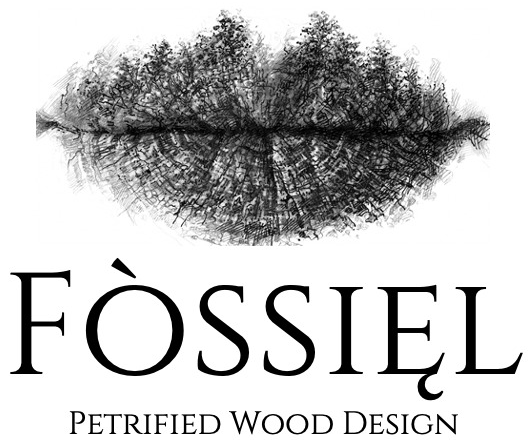What is Petrified wood?
Petrified Wood (from the Latin root Petro meaning ‘rock’ or ‘stone’; literally ‘wood turned into stone’) is the name given to a special type of fossilized remains of terrestrial vegetation. Petrifaction is the result of a tree or tree-like plants having been replaced by stone via a mineralization process that often includes permineralization and replacement. The organic materials making up cell walls have been replicated with minerals (mostly silicane the form of opal, chalcedony, or quartz). In some instances, the original structure of the stem tissue may be partially retained. Unlike other plant fossils, which are typically impressions or compressions, petrified wood is a three-dimensional representation of the original organic material.
Looking for more information?
Use the link below to download our full Fossil Wood Catalog!
Geology. The Study of Time & Pressure.
Tough love has never looked so elegant. Imagine unearthing the journey of this twenty-two-million-year-old and once rough organic canvas. The brute force alone in getting these pieces out of the earth and to the artist's tables is an enormous task. The refiners dedicate a colossal amount of man hours to each and every piece they take on. To achieve the top-quality product Fossięl brings to your eyes and home is truly an art and labor of love like no other. Come on a journey with us millions of years in the making! Be unique. Be petrified!


















Petrified Wood Process
In silicification, the weathering of rocks releases silicate minerals and the silica makes its way into a body of still water. Eventually, the mineral-laden water permeates the pores and cells of some dead organism, where it becomes a gel. Over time, the gel will dehydrate, forming an opaline crystal structure that is an internal cast of the organism. This accounts for the detail found in permineralization. Silicification reveals information about what type of environment the organism was likely to have lived in. Most fossils that have been silicified are bacteria, algae, and other plant life. Silicification is the most common type of permineralization. Petrified wood forms when the woody stems of plants are buried in wet sediments saturated with dissolved minerals. The lack of oxygen slows the decay of the wood, allowing minerals to replace cell walls and fill void spaces in the wood.
Is a process of fossilization in which mineral deposits form internal casts of organisms. Carried by water, these minerals fill the spaces within organic tissue. Because of the nature of the casts, permineralization is particularly useful in studies of the internal structures of organisms, usually plants. The process of permineralization, a type of fossilization, involves deposits of minerals within the cells of organisms. Water from the ground, lakes, or oceans seeps into the pores of organic tissue and forms a crystal cast with deposited minerals. Crystals begin to form in the porous cell walls. This process continues on the inner surface of the walls until the central cavity of the cell, the lumen, is completely filled. The cell walls themselves remain intact surrounding the crystals.
Go back 250 billion and 199 million years ago and take a walk through periods in time such as the Triassic Period, Miocene-Epoch, and the Cenozoic Era as we explain the history and evolution of our one of a kind materials and the world they were created in.
Petwood is most noted for helping us to investigate past-life experiences. It makes the user more aware of nature. It is a warm earthy stone, which is used at the Root Chakra, encouraging one’s survival instincts and grounding. Petwood is also believed to energize the Heart Chakra. In addition to these 2 chakras, It also works to give you wonderful healing energies for both your physical and spiritual issues by supporting the Third Eye. Petwood is enabling the bearer to harness and guide this celestial power. Petwood will help you live your life as a spiritual being in the physical world.
Fossiel Wood Collection
Frequently Asked Questions
Our vision at Fòssięl is to create superior value through the sourcing, repurposing and distribution of our mineralized resources in our art. The sustainable management of our operations is integral to our ability to obtain and maintain our social license to operate and to generate long-term value. We believe our responsible sourcing practices can help promote the protection of human rights, fair and safe labor practices, protection of the environment and ethical business conduct. We also believe that these practices can help create economic opportunity for communities along the supply chain. We uphold high standards in quality and for social and environmental practices.
The colors of the petrified wood reflect the minerals present in the surrounding soil or water that petrify it. Red: Iron (hematite) Orange: Iron (ferric oxy-hydroxides) Yellow: Iron (ferric oxysalts, Uranium Minerals (e.g. carnotite). Green: Ferrous iron (e.g. chlorite), Malachite, Chromium-mica, Uranium Minerals (e.g. torbernite), Nickel (e.g. garnierite). Blue: Light scattering from voids and inclusions, Copper (e.g. azurite), Cobalt salts. Purple/Violet: Manganese (e.g. purpurite), Ferric iron (as in amethyst).Brown: Iron (mixed ferric iron-bearing minerals). Black: Manganese oxy-hydroxides, Graphite, Magnetite, Pyrite. White: Fluid or gas inclusions. Grey: Various dark inclusions.

